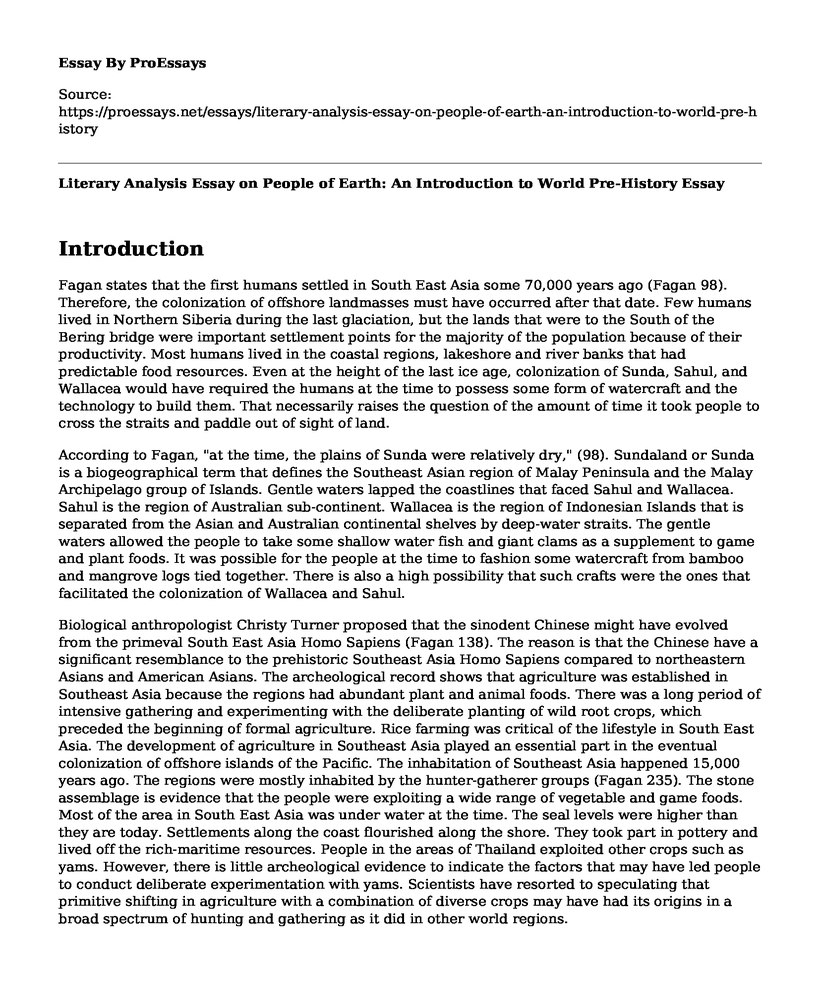Introduction
Fagan states that the first humans settled in South East Asia some 70,000 years ago (Fagan 98). Therefore, the colonization of offshore landmasses must have occurred after that date. Few humans lived in Northern Siberia during the last glaciation, but the lands that were to the South of the Bering bridge were important settlement points for the majority of the population because of their productivity. Most humans lived in the coastal regions, lakeshore and river banks that had predictable food resources. Even at the height of the last ice age, colonization of Sunda, Sahul, and Wallacea would have required the humans at the time to possess some form of watercraft and the technology to build them. That necessarily raises the question of the amount of time it took people to cross the straits and paddle out of sight of land.
According to Fagan, "at the time, the plains of Sunda were relatively dry," (98). Sundaland or Sunda is a biogeographical term that defines the Southeast Asian region of Malay Peninsula and the Malay Archipelago group of Islands. Gentle waters lapped the coastlines that faced Sahul and Wallacea. Sahul is the region of Australian sub-continent. Wallacea is the region of Indonesian Islands that is separated from the Asian and Australian continental shelves by deep-water straits. The gentle waters allowed the people to take some shallow water fish and giant clams as a supplement to game and plant foods. It was possible for the people at the time to fashion some watercraft from bamboo and mangrove logs tied together. There is also a high possibility that such crafts were the ones that facilitated the colonization of Wallacea and Sahul.
Biological anthropologist Christy Turner proposed that the sinodent Chinese might have evolved from the primeval South East Asia Homo Sapiens (Fagan 138). The reason is that the Chinese have a significant resemblance to the prehistoric Southeast Asia Homo Sapiens compared to northeastern Asians and American Asians. The archeological record shows that agriculture was established in Southeast Asia because the regions had abundant plant and animal foods. There was a long period of intensive gathering and experimenting with the deliberate planting of wild root crops, which preceded the beginning of formal agriculture. Rice farming was critical of the lifestyle in South East Asia. The development of agriculture in Southeast Asia played an essential part in the eventual colonization of offshore islands of the Pacific. The inhabitation of Southeast Asia happened 15,000 years ago. The regions were mostly inhabited by the hunter-gatherer groups (Fagan 235). The stone assemblage is evidence that the people were exploiting a wide range of vegetable and game foods. Most of the area in South East Asia was under water at the time. The seal levels were higher than they are today. Settlements along the coast flourished along the shore. They took part in pottery and lived off the rich-maritime resources. People in the areas of Thailand exploited other crops such as yams. However, there is little archeological evidence to indicate the factors that may have led people to conduct deliberate experimentation with yams. Scientists have resorted to speculating that primitive shifting in agriculture with a combination of diverse crops may have had its origins in a broad spectrum of hunting and gathering as it did in other world regions.
Conclusion
Settlements in the Sahul, Sunda and Wallacea regions took part in the later stages of the pre-historic period. Anthropologists had estimated that the event took part around 15,000 years ago when the sea levels were very high. As a result, settlement in these areas would have required the inhabitants to possess some form of watercraft technology. Current evidence suggests that the people might have used simple watercraft by tying bamboo and mangrove logs together. The inhabitants mainly settled on the shoreline where they made a living out of maritime resources. Rice farming was a big part of their agricultural activity, along with yams. Scientists are speculating that the broad spectrum of hunting and gathering in other world regions is what is responsible for the first shifting in agriculture.
Works Cited
Fagan, Brian M. People of Earth: An Introduction to World Pre-History. 13th. Upper Saddle River: Prentice Hall, 2010. Print.
Cite this page
Literary Analysis Essay on People of Earth: An Introduction to World Pre-History. (2022, Dec 14). Retrieved from https://proessays.net/essays/literary-analysis-essay-on-people-of-earth-an-introduction-to-world-pre-history
If you are the original author of this essay and no longer wish to have it published on the ProEssays website, please click below to request its removal:
- Literary Analysis Essay on A Rose for Emily by William Faulkner
- Frankenstein Narrative Analysis Essay
- Essay Sample on The Assassination of Franz Ferdinand
- Annotated Bibliography Example on The Hunger Games
- Essay on Women Pivotal in Civil War: Volunteering, Nursing, Advocating, Spying, and More
- Slavery: The Backbone of British Empire in America - Essay Sample
- Essay Example on Early Dynastic Period: 2900-2350 BCE - A Cultural & Political Transformation







